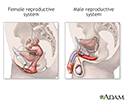Precocious puberty
Pubertas praecoxPuberty is the time when a person's sexual and physical characteristics mature. Precocious puberty is when these body changes happen earlier than normal.
Causes
Puberty usually begins between ages 8 and 13 for girls and ages 9 and 14 for boys.
The exact age a child enters puberty depends on a number of factors, including family history, nutrition, and sex.
Most often there is no clear cause for precocious puberty. Some cases are due to changes in the brain, genetic problems or certain tumors that release hormones. These conditions include:
- Disorders of the testicles, ovaries, or adrenal glands
- Tumor of the hypothalamus (hypothalamic hamartoma)
Hypothalamus
The hypothalamus is an area of the brain that produces hormones that regulate:Body temperatureHeart rateHungerMoodRelease of hormones from many gland...
 ImageRead Article Now Book Mark Article
ImageRead Article Now Book Mark Article - Tumors that release a hormone called human chorionic gonadotropin (hCG)
Symptoms
In girls, precocious puberty is when any of the following develop before age 8:
- Armpit or pubic hair
- Beginning to grow faster
- Breasts
- First period (menstruation)
- Mature outer genitals
In boys, precocious puberty is when any of the following develop before age 9:
- Armpit or pubic hair
- Growth of the testes and penis
- Facial hair, often first on the upper lip
- Muscle growth
- Voice change (deepening)
Exams and Tests
Your health care provider will perform a physical exam to check for signs of precocious puberty.
Tests that may be ordered include:
- Blood tests to check hormone levels.
-
CT or MRI scan of the brain or of the abdomen to check for tumors.
CT
A computed tomography (CT) scan is an imaging method that uses x-rays to create pictures of cross-sections of the body. Related tests include:Abdomin...
 ImageRead Article Now Book Mark Article
ImageRead Article Now Book Mark ArticleMRI
A magnetic resonance imaging (MRI) scan is an imaging test that uses powerful magnets and radio waves to create pictures of the body. It does not us...
 ImageRead Article Now Book Mark Article
ImageRead Article Now Book Mark ArticleAbdomen
An abdominal CT scan is an imaging test that uses x-rays to create cross-sectional pictures of the belly area. CT stands for computed tomography....
 ImageRead Article Now Book Mark Article
ImageRead Article Now Book Mark Article
Treatment
Depending on the cause, treatment for precocious puberty may include:
- Medicines to stop the release of sexual hormones, to help delay puberty. These medicines are given as a shot (injection). They will be given until the normal age of puberty.
- Surgery to remove a tumor.
Children with early sexual development may have psychological and social problems. Children and adolescents want to be the same as their peers. Early sexual development can make them appear different. Parents can support their child by explaining the condition and how their provider plans to treat it. Talking to a mental health worker or counselor may also help.
Possible Complications
Children who go through puberty too early may not reach their full height because growth stops too early.
When to Contact a Medical Professional
See your child's provider if:
- Your child shows signs of precocious puberty
- Any child with early sexual development appears to be having problems in school or with peers
Prevention
Adult prescription medicines and dietary supplements that contain hormones should not be consumed by children.
Your child should maintain a healthy weight.
References
Cooke DW, DiVall SA, Radovick S. Normal and aberrant growth in children. In: Melmed S, Auchus RJ, Goldfine AB, Koenig RJ, Rosen CJ, eds. Williams Textbook of Endocrinology. 14th ed. Philadelphia, PA: Elsevier; 2020:chap 25.
Garibaldi LR, Chemaitilly W. Disorders of pubertal development. In: Kliegman RM, St. Geme JW, Blum NJ, Shah SS, Tasker RC, Wilson KM, eds. Nelson Textbook of Pediatrics. 21st ed. Philadelphia, PA: Elsevier; 2020:chap 578.
-
Endocrine glands - illustration
Endocrine glands release hormones (chemical messengers) into the bloodstream to be transported to various organs and tissues throughout the body. For instance, the pancreas secretes insulin, which allows the body to regulate levels of sugar in the blood. The thyroid gets instructions from the pituitary to secrete hormones which determine the rate of metabolism in the body (the more hormone in the bloodstream, the faster the chemical activity; the less hormone, the slower the activity).
Endocrine glands
illustration
-
Male and female reproductive systems - illustration
The male and female reproductive systems, viewed from a mid-sagittal section.
Male and female reproductive systems
illustration
-
Endocrine glands - illustration
Endocrine glands release hormones (chemical messengers) into the bloodstream to be transported to various organs and tissues throughout the body. For instance, the pancreas secretes insulin, which allows the body to regulate levels of sugar in the blood. The thyroid gets instructions from the pituitary to secrete hormones which determine the rate of metabolism in the body (the more hormone in the bloodstream, the faster the chemical activity; the less hormone, the slower the activity).
Endocrine glands
illustration
-
Male and female reproductive systems - illustration
The male and female reproductive systems, viewed from a mid-sagittal section.
Male and female reproductive systems
illustration
Review Date: 8/5/2023
Reviewed By: Neil K. Kaneshiro, MD, MHA, Clinical Professor of Pediatrics, University of Washington School of Medicine, Seattle, WA. Also reviewed by David C. Dugdale, MD, Medical Director, Brenda Conaway, Editorial Director, and the A.D.A.M. Editorial team.



